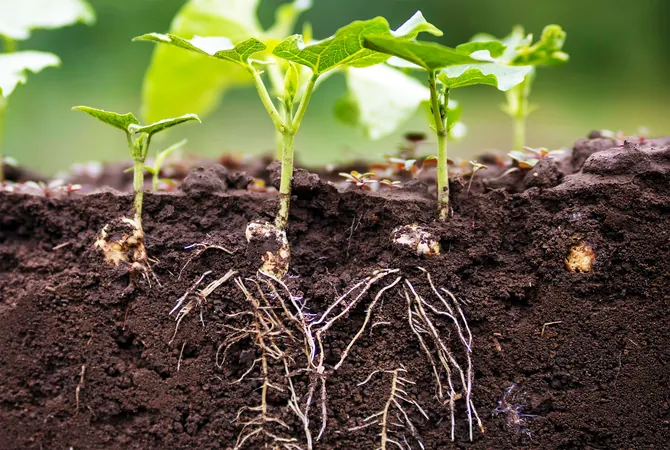
Unlocking Nature's Secrets: How Scientists Discovered the Key to Faster, Stronger Plant Growth!
2025-05-13
Author: Yan
The Quest for Efficient Growth
Every seed’s journey begins with a fundamental goal: to discover water, absorb vital nutrients, and remain upright in the soil. As climate patterns shift dramatically, ensuring that plant roots sprout at the perfect moment has never been more critical.
Revolutionary Findings Through Autophagy
Researchers are now connecting plant growth dynamics to a process called autophagy—a cellular cleanup mechanism that many associate with health benefits linked to fasting. By tracking a flexible protein in Arabidopsis roots, the scientific team has revealed how split-second cleanup cycles can create new branches, empowering crops to thrive under challenging conditions.
The Breakthrough at the University of Copenhagen
Scientists from the University of Copenhagen have meticulously mapped this process in live seedlings. They observed the transcription factor ARF7, which vanished and reappeared in regular cycles, perfectly aligned with spikes in the growth hormone auxin.
"Just as fasting triggers health benefits in humans by activating cellular cleanup, we’ve demonstrated that this mechanism is crucial for plant roots to efficiently absorb water and nutrients," stated Assistant Professor Eleazar Rodriguez, who spearheaded the study.
Autophagy: The Unsung Hero of Plant Development
This process hinges on NBR1, a tagging system that directs worn-out proteins to vacuoles for recycling. Each time ARF7 is removed, the signaling reset allows for a fresh growth cycle to commence a few hours later.
When autophagy slows, ARF7 builds up, disrupting the root's natural rhythm and efficiency.
A Closer Look at Root Behavior
Normally, side branches form with precise timing—about every four to six hours—with auxin levels peaking at the root tips. Rodriguez likens the root’s movement to a snake gliding through the soil in search of water and nutrients.
Testing the Limits of Autophagy
The team experimented by disabling key autophagy genes, resulting in mutant seedlings with fewer lateral roots and diminished water uptake. Imaging revealed vacuoles swollen with waste; growth zones that once detoxified before each auxin pulse remained clogged, stunting root system development.
Why This Discovery Matters
Since this recycling mechanism is widespread in flowering plants, these discoveries pave the way for agricultural advancements and breeding techniques. Considering modern methods to alter plant genetics, scientists aim to cultivate roots that grow deeper and faster, enhancing resistance to drought and flooding.
"Several Danish companies are currently exploring how symbiotic bacteria can modify plant growth patterns," explained Ph.D. student Jeppe Ansbøl, a co-author of the study.
Improving Harvests Through Autophagy
Enhancing autophagy or tweaking NBR1 tags could enable roots to dive deeper for moisture and capture nutrients before they wash away, ultimately boosting harvest outcomes without requiring additional resources.
The Broader Implications for Agriculture
Rodriguez emphasizes, "More roots mean better access to water and nutrients, leading to healthier, faster-growing plants. Our survival hinges on understanding plants thoroughly since they provide food, absorb CO2, and produce oxygen."
Field Trials and Future Research
Pilot projects in Denmark are currently testing these theories amidst fluctuating rainfall patterns. Early results suggest crops with optimized recycling exhibit quicker recoveries after droughts and heavy rains.
Future studies will investigate whether other auxin response factors engage with this recycling pathway and how environmental changes adjust this mechanism.
By uncovering the ancient connections between autophagy and plant development, researchers aim to help farmers achieve tougher yields in a climate characterized by volatility.


 Brasil (PT)
Brasil (PT)
 Canada (EN)
Canada (EN)
 Chile (ES)
Chile (ES)
 Česko (CS)
Česko (CS)
 대한민국 (KO)
대한민국 (KO)
 España (ES)
España (ES)
 France (FR)
France (FR)
 Hong Kong (EN)
Hong Kong (EN)
 Italia (IT)
Italia (IT)
 日本 (JA)
日本 (JA)
 Magyarország (HU)
Magyarország (HU)
 Norge (NO)
Norge (NO)
 Polska (PL)
Polska (PL)
 Schweiz (DE)
Schweiz (DE)
 Singapore (EN)
Singapore (EN)
 Sverige (SV)
Sverige (SV)
 Suomi (FI)
Suomi (FI)
 Türkiye (TR)
Türkiye (TR)
 الإمارات العربية المتحدة (AR)
الإمارات العربية المتحدة (AR)